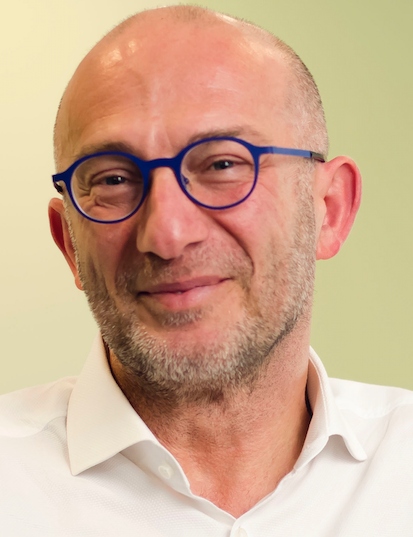Co-Located Conference AgendasExtracellular Vesicles 2022: Technologies Driving Biological Investigations | Lab-on-a-Chip and Microfluidics World Congress 2022 | Organoids & Microphysiological Systems 2022 | Point-of-Care & Rapid Diagnostics 2022 | 

Monday, 12 December 202213:00 | Conference Registration and Materials Pick-Up | |
Session Title: Conference Plenary Session |
| | 14:00 |  | Conference Chair Welcome and Introduction by Conference Co-Chairperson and an Overview of the Field of Lab-on-a-Chip and Microfluidics
Leanna Levine, Founder & CEO, ALine, Inc., United States of America
|
| 14:15 |  | Conference Chair Welcome and Introduction by Conference Co-Chairperson and an Overview of the Field of Lab-on-a-Chip and Microfluidics
Claudia Gärtner, CEO, microfluidic ChipShop GmbH, Germany
|
| 14:30 |  | Plenary Presentation Integrated and Modular Microfluidic Systems for Disease Diagnostics: From Cancer to COVID-19
Steve Soper, Foundation Distinguished Professor, Director, Center of BioModular Multi-Scale System for Precision Medicine, The University of Kansas, United States of America
We are developing unique integrated microfluidic systems that consist of task specific modules interfaced to a fluidic motherboard to carry out multistep assays. The commonality in these modules is that they consist of microfluidic and even nanofluidic devices made from plastics via injection molding. Thus, our tools can be mass produced at low-cost that facilitates bench-to-bed side transition and point-of-care testing (PoCT). We have also been generating novel assays focused on using liquid biopsy samples. Recently, we have focused on developing plastic nanofluidic devices, which provides unique opportunities for single-molecule and single-cell analyses. In this presentation, I will talk about the evolution of our fabrication efforts of plastic-based microfluidic and nanofluidic devices as well their surface modification to make the devices biocompatible. Then, I will discuss several applications of our modular systems and the assays for selection of rare liquid biopsy targets from clinical samples and molecular analysis of their contents to help guide disease management. I will use two examples to highlight the utility of these systems: (1) Analysis of circulating tumor cells (CTCs) using microfluidics for the diagnosis of pancreatic ductal adenocarcinoma (PDAC); and (2) detection of COVID-19 using PoCT from saliva samples. PDAC is a deadly disease with a 5-year survival rate <5%. A microfluidic chip for CTC selection consisted of channels surface-decorated with antibodies that could select CTCs directly from whole blood and enumerate them to determine response to therapy or subject them to next generation sequencing to determine a patient’s response to certain treatments. The COVID-19 diagnostic accepts saliva samples and searches for SARS-CoV-2 particles and counts the number of virus particles selected using a label-free approach; nano-Coulter Counter chip (nCC). Both steps of the assay were carried out using a microfluidic and nanofluidic device, respectively. The chips were integrated to a control board to allow for sample processing automation with results in <20 min. |
| 15:00 |  | Plenary Presentation Picoliter Thin Layer Chromatography (pTLC) for Assay of Lipid Signaling in Single Cells
Nancy Allbritton, Frank and Julie Jungers Dean of the College of Engineering and Professor of Bioengineering, University of Washington in Seattle, United States of America
Lipid signaling pathways regulate a multitude of cellular behaviors in humans including cell proliferation, death, migration, and many other attributes. These pathways are implicated in a host of diseases and many compounds are now in clinical trials to target these signaling cascades. However, most existing technologies for assay of cellular lipids possess poor sensitivity and require large sample volumes making them unsuitable for the assay of mammalian cells which are 1 pL in volume and may possess as little as 10-20 moles of key regulatory lipids. To address this challenge, an array of open microchannels filled with a monolithic silica was developed using microfabrication and sol-gel chemistry. When ultra-small volumes (<1 nL) of fluorescent lipids including [phosphatidylinositol 4,5-bisphosphate, phosphatidylinositol 3,4,5-trisphosphate, phosphatidylcholine (PC), phosphatidylethanolamine (PE), 1,2-dihexadecanoyl-sn-glycero-3-phosphoethanolamine, sphingosine, sphingosine-1-phosphate (S1P), and ceramide] were spotted at the channel inlet followed by separation, the lipids were detectable with excellent sensitivity (10-20 moles). To demonstrate the power of pTLC, leukemic cells were loaded with fluorescent PC, PE or sphingosine and a single cell printed at the inlet of a pTLC channel. PE and PC within a single cell were separated by pTLC in less than 1 min with excellent resolution and detection limits. When cells were loaded with a fluorescent sphingosine, the conversion of sphingosine to S1P was also detected and the reaction blocked by sphingosine kinase inhibitors. These novel biomedical microdevices can be fabricated in large scale arrays for fully automated, high-throughput assay of ultra-small-sized samples as well as for screening of therapeutic modulators of lipid signaling. These and other advances in biomedical microdevices are paving the way for rapid discoveries in basic and pharmaceutical sciences, as well as personalized medicine.
|
| 15:30 |  | Plenary Presentation Vein-to-Vein Microfluidic Engineering for Cell Therapies
Abraham Lee, Chancellor’s Professor, Biomedical Engineering & Director, Center for Advanced Design & Manufacturing of Integrated Microfluidics, University of California-Irvine, United States of America
Adoptive cell therapy (ACT) involves the processing of blood from a donor to isolate T lymphocytes (T cells) for genetic manipulation followed by reinfusion of the cells into patients. The genetic manipulation is carried out by inserting genetic coding material (e.g. DNA, mRNA) into the T cells to express chimeric antigen receptors to target biomarkers of cancer cells and trigger an activated immune response towards the tumor of interest. If the cells are from the same patient it is considered autologous and if from a different donor it is allogenic. Also, different immune cells can be used in addition to T cells, e.g., NK cells, dendritic cells, and CD4+ helper T cells. This process that starts from blood from the vein of one person and ends with specialized engineered cells delivered to the vein of a patient includes multiple tedious and costly steps, and can require a long time that the patient may not have. Microfluidics techniques are being developed that can address all steps of this cell manufacturing process, including cell harvesting, cell isolation, cell expansion, and cell transfection, and has the potential to drastically reduce cost and processing times. In this presentation, I will introduce our microfluidic platforms based on the lateral cavity acoustic transducer for processing blood samples, isolating T cells, transfecting T cells, and finally expanding T cells to scale up for treatment. The LCAT device has been used to isolate leukocytes from whole blood. In particular, I will introduce the acoustic electric shear orbiting poration (AESOP) device that is able to uniformly deliver genetic cargo dosage into a large population of cells simultaneously in comparison with conventional transfection techniques. I will also introduce an another microfluidic method to construct artificial antigen presenting cells for T cell activation. |
| 16:00 | Coffee and Networking Break | 16:30 |  | Plenary Presentation Building a Human Body on a Chip: An Ongoing Journey 1989-20?? — A 33-year Odyssey
Michael Shuler, Samuel B. Eckert Professor of Engineering, Cornell University, President Hesperos, Inc., United States of America
A physiologically representative, multiorgan microphysiological system
(or MPS) based on human tissues may become a transformative technology
to improve selection of drug candidates most likely to earn regulatory
approval from clinical trials. Also, such systems can be used to test
cosmetics, food ingredients, and chemicals for potential toxicity. In
this talk we will explore the history of the development one type of MPS
known as a "Body-on-a-Chip" as well as current and future elaborations
of this technology. Current "Body-on-a-Chip" systems combine organized
tissue/organ mimics with the techniques of microfabrication based on
PBPK (Physiologically Based Pharmacokinetic) models. Currently these
systems are "self-contained" and do require external pumps, leading to
"pumpless systems" which eliminates the need for an external pump,
reduces system cost and improves operational reliability. While the
fluid (or blood surrogate) in these systems can be sampled directly to
allow measurement of concentrations of drug, metabolites or biomarkers,
they can also be interrogated in situ to determine functional responses
such as electrical response, force generation, or barrier integrity. The
blood surrogate can be made to be as a serum-free, chemically defined
medium facilitating interpretations of responses that are more
mechanistic than with serum containing media. A key advantage of this
approach is that we can predict both human efficacy and toxicity of a
drug or drug combination in preclinical trails, A Hesperos system has
been used as the sole source of efficacy data for an IND application by
Sanofi for a drug currently in a Phase 2 clinical trial and data from an
Emulate system has also been used to support an IND. For these systems
to fulfill their real potential in drug development such use of these
systems must become routine. Further there are questions on human
toxicity of cosmetics and other chemicals, particularly mixtures, that
can be addressed with such systems. |
| 17:00 |  | Plenary Presentation Droplet-based Microfluidics Original Droplet-based Digital PCR Assays to Detect Circulating Biomarkers
Valérie Taly, CNRS Research Director, Professor and Group leader Translational Research and Microfluidics, Université Paris Cité, France
Droplet-based microfluidics has led to the development of highly powerful systems that represent a new paradigm in High-Throughput Screening where individual assays are compartmentalized within microdroplet microreactors. The integration of such systems for series of complex individual operations on droplets has offered a solution to the necessary miniaturization and automation of individual biological assays. By combining a decrease of assay volume and an increase of throughput, this technology goes beyond the capacities of conventional screening systems. The presentation will aim at demonstrating through selected example, the great potential of this technology for biotechnology and cancer research. In particular, we will show how by combining microfluidic systems and clinical advances in molecular diagnostic we have developed an original method to perform millions of single molecule PCR in parallel to detect and quantify a minority of target sequences in complex mixture of nucleic acids with a sensitivity unreachable by conventional procedures. This presentation will both cover early developments of droplet-based digital PCR and more recent one dedicated to the highly sensitive multiplex detection of micro-RNA. |
| 17:30 |  | Plenary Presentation Precision Microfluidics of Large Volumes
Mehmet Toner, Helen Andrus Benedict Professor of Biomedical Engineering, Massachusetts General Hospital (MGH), Harvard Medical School, and Harvard-MIT Division of Health Sciences and Technology, United States of America
Microfluidics gained prominence with the application of microelectromechanical systems (MEMS) to biology in an attempt to benefit from the miniaturization of devices for handling of minute samples of fluids under precisely controlled conditions. Microfluidics exploits the differences between micro- and macro-scale flows, for example, the absence of turbulence, electro-osmotic flow, surface and interfacial effects, capillary forces in order to develop scaled-down biochemical analytical processes. The field also takes advantage of MEMS and silicon micromachining by integrating micro-sensors, micro-valves, and micro-pumps as well as physical, electrical, and optical detection schemes into microfluidics to develop the so-called “micro-total analysis systems (microTAS)” or “lab-on-a-chip” devices. However, the ability to process ‘real world-sized’ volumes efficiently has been a major challenge since the beginning of the field of microfluidics. This begs the question whether it is possible to take advantage of microfluidic precision without the limitation on throughput required for large-volume processing? The challenge is further compounded by the fact that physiological fluids are non-Newtonian, heterogeneous, and contain viscoelastic living cells that continuously responds to the smallest changes in their microenvironment. Our efforts towards moving the field of microfluidics to process large-volumes of fluids was counterintuitive and not anticipated by the conventional wisdom at the inception of the field. We metaphorically called this “hooking garden hose to microfluidic chips.” We are motivated by a broad range of applications enabled by precise manipulation of extremely large-volumes of complex fluids, especially those containing living cells or bioparticles. This presentation will provide a summary of our efforts in bringing microfluidics to large volumes and complex fluids. The use of high-throughput microfluidics to process large-volumes of complex fluids (e.g., whole blood, bone marrow, bronchoalveolar fluid) has found broad interest in both academia and industry due to its broad range of utility in medical applications. |
| 18:00 | Networking Reception with Beer, Wine and Dinner in the Exhibit Hall -- Network with Colleagues and Engage with the Sponsors-Exhibitors | 19:30 | Close of Day 1 Main Conference Programming |
Tuesday, 13 December 202208:00 | Conference Registration, Morning Coffee, Tea and Pastries | |
Session Title: Emerging Themes in Microfluidics and the Lab-on-a-Chip and Companies in the Field |
| | 09:00 |  | Keynote Presentation Linking Genes to Function for Thousands of Single Cells Using Nanovial Technology
Dino Di Carlo, Armond and Elena Hairapetian Chair in Engineering and Medicine, Professor and Vice Chair of Bioengineering, University of California-Los Angeles, United States of America
We have developed 3D-shaped hydrogel microparticle platforms to capture cells, as well as isolate and label their secretions. These “lab on a particle” systems enable sorting cells based on secreted products for the discovery of antibodies, the development of cell lines producing recombinant products, and the selection of functional cells for cell therapies. Each cell and its secreted products can be analyzed using widely available flow cytometers and single-cell sequencing instruments, promising to democratize single-cell technologies. I will discuss our latest results linking the transcriptomes of single cells to the secreted products they produce. I will cover two example applications of this secretion encoded single-cell sequencing (SEC-seq) workflow. In a first example we uncover gene networks associated with high secretion of immunoglobulin G in human plasma cells, one of the most highly secreting cell types in the body. In a second application we characterize a unique transcriptionally-defined cluster of mesenchymal stromal cells (MSCs) that secrete higher levels of vascular endothelial growth factor (VEGF). VEGF is a pro-regenerative growth factor that is thought to drive therapeutic benefit in MSC-based therapeutics. I will summarize the potential for nanovial technology to promote understanding and engineering of functional properties in single cells, and ultimately drive the next-generation of cell therapies. |
| 09:30 |  Be Nice to Your Cells! Gentle Cell Handling with Microfluidics for Better Results Be Nice to Your Cells! Gentle Cell Handling with Microfluidics for Better Results
Magdalena Schimke, Business Development and Sales, Single Cell Diagnostics, STRATEC Consumables GmbH
The usability of cell handling – isolation, sorting, screening, analysis – is extremely broad in research, pharma and therapy. Yet, it is far beyond trivial to maintain the cells in their state of need for the specific task and physical/chemical manipulation is inducing potential changes with effects on the cell’s activities with potential negative effects on the outcomes. In this presentation, we discuss the challenges and risks of novel microfluidic designs to maintain the cell’s happiness and proper functionality.
| 10:00 |  Aspects of Transferring Early Stage Microfluidic Prototypes to Scalable Consumables Aspects of Transferring Early Stage Microfluidic Prototypes to Scalable Consumables
Sebastian Stöckeler, Senior Vice President, z-microsystems
| 10:30 | Mid-Morning Coffee, Tea and Networking in the Exhibit Hall | 11:00 | All-in-One Optofluidic System for Molecular Biomarker Analysis
Holger Schmidt, Narinder Kapany Professor of Electrical Engineering, University of California-Santa Cruz, United States of America
Optofluidics is the integration of integrated photonics with microfluidics in order to create more fully integrated labs--on-chip. I will discuss the development of a PDMS-based optofluidic platform that combines sample processing, an optical excitation source and optical analysis on a single chip. Planar liquid-core waveguide technology and the dynamic reconfigurability afforded by flexible chip materials are combined to create a new class of devices for ultrasensitive detection of molecular biomarkers with single molecule sensitivity. The incorporation of electronic integration and advanced signal processing methods for real-time analysis at the point of care will be discussed. | 11:30 |  Microfluidics and Microfabrication Techniques : Introduction to Our Complete Range of Solutions Microfluidics and Microfabrication Techniques : Introduction to Our Complete Range of Solutions
Nicolas Brillouet, CTO, Kloé
Over the last 15 years, Kloé company developed a complete range of equipment dedicated to UV lithography applications, in perfect agreement with the microfabrication requirements in Microfluidics. Indeed, Kloé company did the bet, in the early 2000, that the development of researches and industry in Microfluidics would rapidly grow. So that, over the same time, Kloé company continuously followed and exchanged with the microfluidics community to first well understand and then anticipate its needs in terms of microfabrication techniques and performance, to now enable fabricating from simple to more demanding microfluidic chips like Lab on a Chip. Today, Kloe range of equipment is composed of more than 10 machines, covering from soft lithography techniques (UV-KUB range) to very high resolution 3D printing (Dilase 3D) via direct laser writers (Dilase range) particularly suitable for fast prototyping, high aspect ratio patterning as well as thick layers processing, which ensures all our partners to benefit from the most performing and cost effective solution, in agreement with their expected level of performance and available budget.
| 12:00 |  | Keynote Presentation 3D Printed Structurally Encoded Liquid Handling Algorithms Executed Step-by-Step Via a Microfluidic Chain Reaction
David Juncker, Professor and Chair, McGill University, Canada
|
| 12:30 |  Development of Microfluidic Technologies for Cell Processing and QC Development of Microfluidic Technologies for Cell Processing and QC
Shaheen Jeeawoody, Senior Systems Integration Engineer, Triple Ring Technologies
Quality control tests are essential for any cell therapy manufacturing process. Quality control assays performed “in-line” or “at-line” allow much faster feedback loops in the manufacturing process, motivating a point-of-use approach. Towards that end, Triple Ring Technologies developing user-friendly that leverage microscale phenomena to assess the quality of cell therapy manufacturing processes and products in a high-precision, high-throughput, and point-of-use manner. I shall share some of our work developing microfluidic cartridges integrated with optical imaging for on-chip multiplexed QC of critical cell samples.
| 13:00 | Networking Luncheon in the Exhibit Hall -- Network with the Exhibitors, View Posters and Engage with Colleagues | |
Session Title: Fields Around the Nexus of Microfluidics-LOAC and Companies in these Fields |
| | 14:00 | Microfluidics for Fertility
Reza Nosrati, Senior Lecturer, Monash University, Australia
Microfluidic methods offer several advantages over their traditional macro-scale counterparts by extending the possibility of biomedical research based on the idea of miniaturization. These miniaturized platforms provide opportunities to manipulate cells and biological processes at the single-cell level and develop nature-inspired technologies for diagnostic and therapeutic applications. For example, in the context of fertility, microfluidics can match the geometry of micro-confined regions within the female reproductive tract, thus, presenting opportunities for fundamental understanding of the even of fertilization and biomimicry-based selection of sperm that reflect the in vivo process. In this talk, I will provide an overview of our work in developing microfluidic technologies for sperm analysis and selection. | 14:30 | Breaking the Mold: Unconventional and Powerful Point of Care Viral Diagnostics For the Post-COVID Era
Brian Cunningham, Professor and Intel Alumni Endowed Chair, University of Illinois at Urbana-Champaign, United States of America
The COVID-19 pandemic offered an unprecedented urgent challenge to society’s systems for surveillance and control of a highly contagious and deadly pathogen. However, despite their limitations, the most heavily utilized diagnostic technologies remain those based upon laboratory PCR for detection of viral nucleic acids, and lateral flow strips for self-testing of viral antigens. Nonetheless, unconventional approaches that offer more rapid results, lower detection limits, lower cost/assay, and simpler workflows are emerging that are poised to change the existing paradigms for infectious disease detection. As we consider preparation for potential future pandemics, we also aim to provide more effective approaches for the still-unmet needs of insect-borne viruses, HIV, animal diseases, and others. This presentation will describe viral diagnostics using newly-developed biosensor technology combined with novel biochemistry methods demonstrated by the University of Illinois at Urbana-Champaign Center for Genomic Diagnostics since March 2020. Beginning with microfluidic isothermal nucleic acid amplification reactions detectable with a smartphone camera for SARS-CoV-2 in saliva, we are developing a self-contained, 4x multiplexed microfluidic cartridge for detection of Zika, Dengue, and Chikungunya from a droplet of whole blood in ~20 minutes with a smartphone clip-on reader. As an alternative to nucleic acid sequence detection, sample preparation can be greatly simplified through direct detection of intact virions. Therefore, we developed a simple 1-step, 5-minute assay for detection of intact SARS-CoV-2 using designer DNA origami “nets” that release fluorophores when they specifically bind with the pattern of outer spike proteins on the virus for detection with a ~$50 pocket-size smartphone-linked fluorimeter. In a further novel approach, spike-binding DNA aptamers are used to capture intact HIV and SARS-CoV-2 virions to a photonic crystal biosensor, where they can be rapidly imaged and digitally counted through interferometric scattering of laser illumination. Finally, we developed 1-step, room temperature, enzyme-free, ultraselective, 10-minute detection of specific RNA sequences using nucleic acid strand displacement reactions that, when combined with photonic crystal biosensor microscopy, provides ~500x lower detection limit than PCR. The limitations of the prevailing test methods deployed to counteract SARS-CoV-2, now clearly understood, provide a roadmap for transforming pathogen detection. When fully developed, the unconventional methods will enable society to more effectively manage infectious disease. | 15:00 |  Point-of-Care Molecular Testing Platform for COVID Testing and Lessons Learned Point-of-Care Molecular Testing Platform for COVID Testing and Lessons Learned
Ming Tan, CTO, Wainamics Inc.
Point-of-care (POC) molecular testing allows rapid direct measurement of the molecular signature in infectious diseases. This allows for identification of the infectious agent at low copy numbers. Wainamics has developed multiple SARS-CoV2 testing platforms in collaborations with our partners, including AmplifiDX and UC Berkeley Innovative Genomic Institute. We present here a unique approach for rapid development of disposable microfluidic systems for nasal swab or saliva sample testing, as well as the lessons learned during the development cycle. The key technology is Wainamics’ innovative, patented microfluidic cartridge that allows sample to answer detection. It has a single lysing solution blister on cartridge that releases lysing solution to the sample chamber. Primer and master mix are sealed on cartridge. The cartridge does not contain any moving parts or integrated on cartridge valves. The cartridge is manufactured using injection molding and die-cut lamination, allowing low cost and high-volume manufacturing. Our platform requires minimum training. After inserting sample into the cartridge, the user simply inserts the cartridge into the machine. All bio-assay steps are performed automatically in the instrument.
| 15:30 | Mid-Afternoon Coffee and Tea Break and Networking in the Exhibit Hall | |
Session: 3D-Printing of Microfluidics |
| | 16:00 |  What Makes Asiga Unique, and Why it is Important for Microfluidic 3D Printing What Makes Asiga Unique, and Why it is Important for Microfluidic 3D Printing
Cory Lambertson, General Manager Americas, ASIGA
In this presentation Cory Lambertson will cover how the Asiga 3D Printing technology is unique which leads to why Asiga is the trusted hardware for fabrication of custom microfluidic devices.
| 16:30 | Advanced 3D Printing for Microfluidics
Gregory Nordin, Professor, Brigham Young University, United States of America
While there is great interest in 3D printing for microfluidic device fabrication, a main challenge has been to achieve feature sizes that are in the truly microfluidic regime (<100 µm). The fundamental problem is that commercial tools and materials, which excel in many other application areas, have not been developed to address the unique needs of microfluidic device fabrication, which focus on negative space features. Consequently, we have created our own stereolithographic 3D printers and materials that are specifically tailored to meet these needs. We have shown that flow channels as small as 18 µm x 20 µm can be reliably fabricated, as well as compact active elements such as valves and pumps. With these capabilities, we demonstrate highly integrated 3D printed microfluidic devices such as a 10-stage 2-fold serial dilutor that simultaneously creates a 3 order of magnitude range of concentrations, and high density chip-to-chip interconnects (53 interconnects per square mm) that are directly 3D printed as part of a device chip. These advances open the door to 3D printing as a replacement for expensive cleanroom fabrication processes, with the additional advantage of fast (~5-10 minute), parallel fabrication of many devices in a single print run due to their small size. | 17:00 | Rapid Manufacturing of mRNA Lipid Nanoparticles in a 3D Printed Microfluidic Device
Noah Malmstadt, Professor, Mork Family Dept. of Chemical Engineering & Materials Science, University of Southern California, United States of America
Lipid nanoparticles (LNPs) have proven to be effective delivery vehicles for mRNA payloads, with LNP-based vaccines proving highly effective in combating the SARS-CoV-2 virus. Beyond mRNA vaccines, LNPs have broad applications in oligonucleotide delivery for a host of applications. LNPs are assembled on the basis of ionic interactions between polyanionic oligonucleotides and cationic lipids; control over the total lipid composition of the particle allows for its pharmacological properties to be engineered. Assembly of the oligonucleotide-lipid complex requires rapid mixing on short length- and time-scales. This is typically accomplished in microfluidic channels, often with channel features such as staggered herringbone mixers (SHMs) to facilitate rapid homogenization of the lipid (in ethanol solution) and oligonucleotide (in aqueous solution) streams. We have designed a 3D-printable microfluidic device that improves on the LNP manufacturing state of the art in terms of both particle uniformity and manufacturing throughput. This is facilitated by the unique advantages that 3D printing brings to microfluidic fabrication. For instance, the lipid and RNA streams are brought together at a junction that focuses the lipid stream in two orthogonal planes, centering it in the channel where it is in uniform contact with the RNA stream. The combined streams are then mixed in a SHM that is routed in three dimensions along a zig-zag path, adding chaotic advection mixing beyond that which is achieved by a simple linear SHM.
Using a lipid composition and mRNA sequence that matches the make-up of the Moderna SARS-CoV-2 vaccine, we were able to produce highly uniform LNPs that matched the size and nanostructure of the particles present in the commercial vaccine. The encapsulation efficiency of RNA in our device, which can exceed 90% with the proper flow rate tuning, is greater than that of currently available commercial LNP manufacturing devices. | 17:30 |  Where Photonics Meet Microfluidics – Consumables for Life Sciences and Diagnostics in Glass Where Photonics Meet Microfluidics – Consumables for Life Sciences and Diagnostics in Glass
Tobias Bauert, Business Development Manager, IMT Microtechnologies
Material choice for microfluidic flow cells or biochips is not so much a choice in many cases but a given specification. The application defines the material in most cases. Microfluidic consumables made of glass dominate the applications where photonics meet microfluidics. The way scaling up from proof-of-concept prototypes to the lab-on-a-chip application in large quantities is full of challenges. The overall complexity is addressed for glass microfluidics by transferring protocols, processes, and equipment available in the MEMS industry into the field of microfluidics. The easy scalability of these processes from single wafer to large volumes is the key to a smooth scale-up with little surprises.
| 18:00 |  Membrane Integration Strategies for Microfluidic Applications, Examples from Cell Culture and Organ on Chip Membrane Integration Strategies for Microfluidic Applications, Examples from Cell Culture and Organ on Chip
Stefano Begolo, Director of Microfluidic Engineering, ALine, Inc.
In this presentation we will review examples of commercially available porous membranes integrated into microfluidic devices. The properties of porous membranes have been leveraged to achieve cell co-culture, precision flow control, filtration and to control gas exchange between different solutions or compartments. These capabilities allow implementation of various applications into integrated microfluidic devices, including cell culture and Organ-on-Chip. We will also discuss integration strategies compatible with scale up manufacturing, to support commercialization of these devices.
| 18:30 | ALine and Natech Plastics invite you to an open house at ALine's headquarters, 2799 Temple Ave., Signal Hill, CA. Join them for Food, Drinks, Networking, Tours & Product Demos. 6:30PM - 8:30PM. For Details and RSVP, Click this Link
Please click this link for full details and RSVP:
|
Wednesday, 14 December 202208:00 | Morning Coffee, Tea and Pastries in the Exhibit Hall | |
Please View Agenda in the Microphysiological Systems Track for Morning Agenda |
| |
|


 Add to Calendar ▼2022-12-12 00:00:002022-12-14 00:00:00Europe/LondonLab-on-a-Chip and Microfluidics World Congress 2022Lab-on-a-Chip and Microfluidics World Congress 2022 in Long Beach, CaliforniaLong Beach, CaliforniaSELECTBIOenquiries@selectbiosciences.com
Add to Calendar ▼2022-12-12 00:00:002022-12-14 00:00:00Europe/LondonLab-on-a-Chip and Microfluidics World Congress 2022Lab-on-a-Chip and Microfluidics World Congress 2022 in Long Beach, CaliforniaLong Beach, CaliforniaSELECTBIOenquiries@selectbiosciences.com